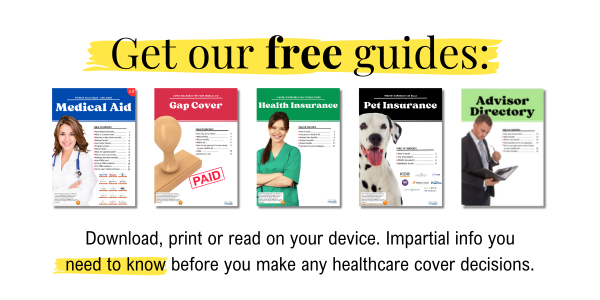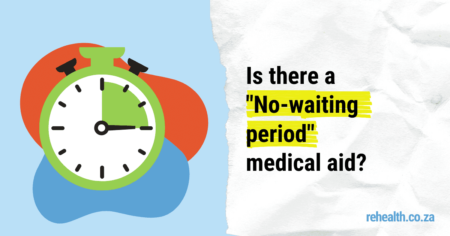Are you overwhelmed by your medial aid premiums? We’ve included some suggestions for how to save money on your medical aid, without having to outright cancel or compromise your needed benefits.
1. Stop paying for all your kids, but still keep them on the medical aid
If you have more than 2 kids, consider moving to a plan that only charges for 2 or 3 children, with the rest free.
Most schemes have at least some plans that set a maximum cap for how many children are charged for. Example:
Discovery: Pay for maximum 3 children on most plans. View all Discovery plans here.
Medihelp: Pay for maximum 2 children on some plans. View all Medihelp plans here.
Bonitas: Pay for maximum 3 children on some plans. View all Bonitas plans here
View all open medical aid plans here, or compare any two plans here.
2. Use a Network Plan
By limiting your choice of hospitals, you can save up to 25% of your premiums. You can still go to any hospital in an emergency, and you can still choose a plan that has your favourite hospital on its network. As an added benefit, some gap covers pay the penalty for going to a hospital outside your network, so you get the best of both worlds. Example: Discovery Essential Core Delta is an entry level hospital plan that requires network hospital and costs 20% less than its non-network equivalent.
3. Consider an income-based plan
If the highest paid medical aid member of your household makes less than about R15,000 per month, you might qualify for capitated plans. These are full medical aid plans, but with the premiums adjusted to your income. The lower your income, the lower your premium. These plans often also have generous out-of-hospital benefits, as an added bonus. You can view the cheapest medical aid plans here.
4. Don’t pay for benefits you don’t need
For example, consider moving to a plan that only covers the in-hospital costs at 100% scheme rate and take a gap cover to make up the difference. Usually, you come out way ahead by choosing a lower plan with a gap, than a higher plan with no gap. Of course, speak to your broker before making this decision.
Also, if you are not planning on having (more) kids, don’t choose a plan that is strong on maternity and childcare benefits. (Although, to be fair, most plans now offer maternity benefits as a default).
5.Get a full review of your needs vs your benefits
Ask your broker to assess your needs vs your plan’s benefits. You should definitely do this at least once per year – the best time is October or November when new plans for the following year come out, and you can change plans within your scheme with no penalty. But, most schemes allow you to make at least some plan changes during the year too (sometimes limited to downgrading your plan only), and you can always change schemes at any time in the year.
6. Split your family across different plans…
If you have one member with extensive medical needs, maybe consider put him or her on a higher plan, and move everyone else to a lower plan. You could still only pay one gap cover, if applicable, even if you’re on different plans. Remember, you are not tied to any decision for more than 12 months, because you can always change your plans in January.
This also applies to students, who could move away from their parents high-end plan, and move to a student friendly plan at a fraction of the cost.
Splitting families can save you thousands, but can get quite technical. Always speak to your broker first, and watch out for waiting periods.
7. … Or move a split family onto one plan
Conversely to number 6 above, if you are paying for a medical aid membership for people who are financially reliant on you (your parents, for example), it might be cheaper to move them to your plan. This needs to be assessed on a case-by-case basis, so speak to your broker and watch out for possible waiting periods.
8. Check your late joiner penalties!
We can’t say enough about this. If you are paying a Late Joiner Penalty, have it evaluated by someone who knows what they are doing. We regularly find people are overpaying their LJPs by R1000s per year.
9. Keep your savings to yourself
Consider choosing a hospital plan over a savings plan, and put the difference every month into your bond or credit card debt. If you need the savings at some stage, you simply pull them out of your credit card/bond instead of the medical aid’s saving account. The claim benefits stay exactly the same, but you get a proper rate of interest while you don’t need the money.
Of course, this only works if you are financially responsible to actually save the extra money, and if you can float your out-of-pocket expenses for some months in case you have a medical emergency early in the year. Also, don’t take this as financial advise…just a suggestion to consider your options. Always speak to a professional.
10. Check those PMBs!
Make sure that your chronic and other out-of-hospital bills that are PMBs are paid for by the scheme and not by you. Where applicable, use the scheme’s contracted doctors to minimise out of pocket expenses, especially for PMBs. You can find out more about PMBs here. Remember, even if you do not use the contracted doctors, the scheme still has to cover at least some of the costs.








